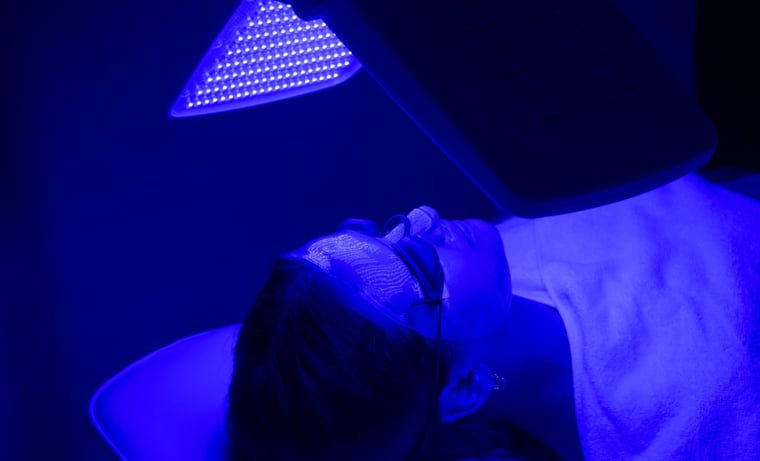

Blue Light Therapy Treatment
in Mequon, WI
What Is Blue Light Therapy?
Blue light therapy, also known as photodynamic therapy, is a type of light treatment that’s used to treat diseased or damaged skin. It uses medications called photosensitizing agents along with specific wavelengths of blue light to destroy abnormal skin cells while leaving the surrounding tissue unharmed.
What Can Blue Light Therapy Treat?
Dermatologists frequently use blue light therapy to prevent skin cancer and treat precancerous and cancerous skin growths. The FDA has approved photodynamic therapy for the treatment of actinic keratosis, a type of pre-cancer that develops on the skin from years of exposure to the sun. Actinic keratoses appear as rough, scaly patches on the skin that may be light or dark tan, flesh-toned, red, or white in color. Photodynamic therapy is an optimal treatment for anyone who has multiple lesions since they can all be treated at once.
In addition to treating and preventing skin cancer, photodynamic therapy is also used to treat sun damage, sun spots, and rosacea. Our dermatologists also offer blue light for acne, and it has become a popular treatment option for acne sufferers who want to eliminate traditional topical treatments and medications.
REQUEST NOWHow Effective Is Blue Light Therapy for Acne?
Blue light therapy for acne works by penetrating deep into your pores to kill acne-causing bacteria. Photodynamic therapy can treat active acne and also prevents outbreaks from occurring in the future. Once the bacteria that causes acne is destroyed, active acne lesions clear up. The treatment also has anti-inflammatory benefits, can reduce the size of the sebaceous glands, and can diminish the appearance of acne scars.
Blue light for acne is appropriate for all areas of the body and is the most effective in the treatment of mild to moderate acne. Treatment is typically administered every two to four weeks, and most patients require a series of three to five appointments. The number of treatments needed depends on your skin type and the severity of your acne. During your appointment, your Forefront dermatologist will create a customized treatment plan.
You can expect a noticeable reduction in acne within two to four weeks. You’ll need to visit your dermatologist for follow-up visits to maintain your results.

What Happens During a Blue Light Treatment Session?
The blue light treatment session consists of three steps. During the first step, your dermatologist applies the photosensitizing agent to your skin. This is the medication that makes certain types of skin tissue, such as precancerous lesions, more susceptible to the absorption of light wavelengths used during treatment.
After your dermatologist applies the photosensitizing agent, you’ll begin the second stage of the treatment process, called the incubation period. During this step, the photosensitizing medication is absorbed into your skin. Depending on the area being treated, this step can take several hours.

Once the compound has been absorbed, blue light is applied. Exposure to blue light causes a reaction in the skin, destroying the targeted skin tissue. The blue light only targets the tissues that absorbed the photosensitizing medication. During blue light exposure, you might feel a mild tingling or burning sensation, but this is only temporary.
Our skilled Board-Certified Forefront dermatologists will design a treatment plan that ensures the best possible results. During your follow-up exam, your dermatologist will examine your skin to make sure that you’re healing well and that the desired results have been achieved. At this time, we’ll discuss whether you need any more treatments. If you don’t require any additional treatments, your dermatologist will recommend a checkup once a year to ensure that your skin is healthy and identify any signs of concern that may indicate future maintenance treatments.

What Can I Expect After Blue Light Skin Treatment?
After blue light skin treatment, your skin will be very sensitive, and you may experience skin redness and swelling. Your skin may also peel or appear flaky, similar to the way it looks after a sunburn. These effects are only temporary and will subside over a period of a few days to a week. To alleviate swelling, you can apply ice or cold packs to the treated area.
Your dermatologist will recommend avoiding the sun or any exposure to bright light for at least 48 hours after treatment. This is because the photosensitizing medication makes your skin very sensitive to the sun, increasing your risk of a severe sunburn. After 48 hours have passed, you can resume your everyday activities, although you should wear sunscreen during any time spent outdoors.
1 Location in the Mequon, WI area
Interested in Blue Light Therapy? Request a consultation with a skin specialist today.
*Treatment options may vary at each location.Please confirm your desired treatment is offered at your preferred location when scheduling. *Age Restriction.
For patients scheduling who are under 18 years of age (19 in Alabama) please make sure you have permission from your parent or legal guardian to schedule this appointment. Your parent or legal guardian must accompany you on your initial visit and on certain subsequent visits to provide appropriate informed consent.